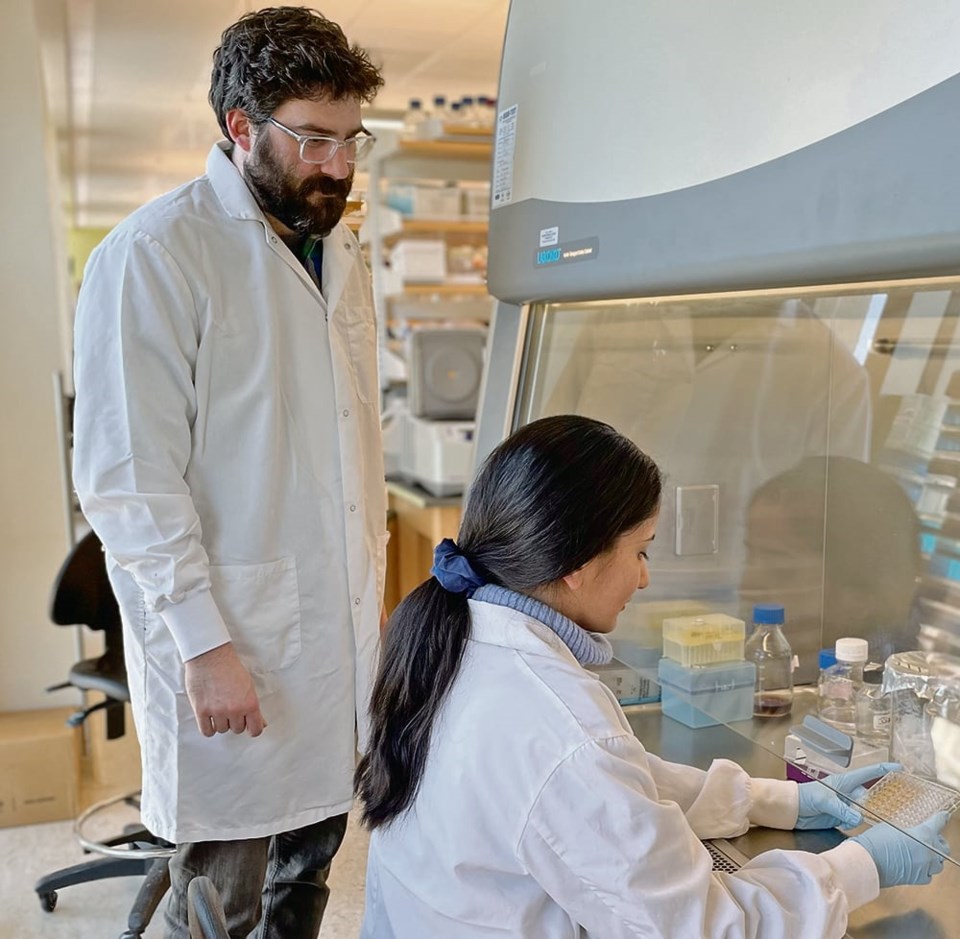WESTERN PRODUCER — Scientists have found that an antimicrobial resistance gene in bacteria collected at a western Canadian feedlot creates an enzyme that can deactivate drugs used to treat diseases in cattle and other livestock.
The EstT enzyme can affect macrolides antibiotic drugs such as tylosin, also sold as Tylan, which is a common additive in feed to help prevent liver abscesses in cattle in feedlots, said Tony Ruzzini, assistant professor at the Western College of Veterinary Medicine at the University of Saskatchewan.
The enzyme can also affect tilmicosin, or Micotil, which helps treat bovine respiratory disease in beef and dairy cattle, he said. The illness, commonly known as shipping fever, is a major cause of mortality in feedlots.
EstT can also affect tildipirosin, also sold as Zuprevo, which is another way to treat bovine respiratory disease, said Ruzzini. These three specific drugs are not used to treat humans, he said.
The discovery that the gene encodes an enzyme that can make such drugs less effective was made after analyzing bacteria collected from watering bowls at a feedlot in Western Canada. The study involved feedlots in Alberta and Saskatchewan starting in 2022, said Ruzzini.
“The concern is that if you have this enzyme that destroys the drug, then you may not be actually providing any protection with the drug. And the fact that we find this drug often in environmental sources in the feedlot, that may mean that there’s quite a bit of inactivation of the drug going on, but that’s something we still need to study.”
The problem might extend beyond cattle to other types of livestock. For example, tylosin is also used to treat American foulbrood disease in honeybees, as well as to treat dysentery, porcine proliferative enteropathy and ileitis in pigs, said Ruzzini in an email.
Other uses include treating chickens for chronic respiratory disease and necrotic enteritis, along with treating sinusitis in turkeys, and helping dogs and cats affected by diarrhea and gastrointestinal issues, he said. Tilmicosin is also used to treat respiratory disease in sheep, he added.
However, it is too early to tell if farmers and ranchers need to change how they treat their animals with such drugs, said Ruzzini in an interview. Scientists need to further study the problem, and not only because the drugs can be a significant expense for producers.
Antibiotics are increasingly becoming less effective because of the global spread of antimicrobial resistance in environments ranging from hospitals to farms. At least 1.2 million human deaths were estimated to have been caused in 2019 by drug-resistant infections, along with many millions more who potentially died, said an analysis published in 2022 in The Lancet.
The gene that encodes the EstT enzyme was studied by a WCVM research team led by Ruzzini in collaboration with Murray Jelenski, who is the Alberta Chair in Beef Cattle Health and Production Medicine and a professor of large animal clinical sciences.
The team’s findings were recently published in a paper in the Proceedings of the National Academy of Sciences that featured post-doctoral fellow Poonam Dhindwal as the lead author.
Although thousands of antimicrobial resistance genes and resistance-conferring mutations are currently known, the catalogue is incomplete, said the paper.
“Blind spots — novel and unreported (antimicrobial resistance genes) — pose unknown risks to human health, animal wellness, and the sustainability of agriculture.”
The paper pointed to an enzyme called EstX whose function is unknown. It was found in the 1980s alongside a known antimicrobial resistance gene in bacteria isolated from pigs, people and sewage.
EstX shares a 44 percent identity with EstT, “making our characterization of EstT a case study in how poorly annotated genes can go unnoticed or unstudied for decades despite a pattern of proximity to known and readily identified (antimicrobial resistance genes). Ultimately, our results speak to a need for systematic analyses to identify new (antimicrobial resistance genes) based on how they are collectively disseminated.”
Scientists are looking at improving surveillance of microbes around feedlots and other agricultural operations using methods such as sampling watering bowls, which doesn’t disrupt livestock. He pointed to how researchers have tested for the level of COVID-19 in cities such as Calgary by examining the collective waste water from sewage rather than individually testing each resident.
The ability of scientists in Western Canada to detect antimicrobial resistance is increasing because of investments in veterinary diagnostic laboratories, said Ruzzini. The presence of macrolides drugs might inform future studies that could examine the effectiveness of different feed additives or strategies to treat diseases in livestock, he said.
“And then the longer-term view would be if we do use molecular tools to detect antimicrobial resistance genes, then we may or may not be able to say at a given feedlot there’s an enrichment of resistance genes for this set of drugs, so maybe we should treat with this other set. But that’s probably not in the immediate future.”
Scientists had previously determined that the gene that encoded the EstT enzyme was a common part of many pathogens that affect animals and their microbiomes. Although its function was unknown, it was located next to three other genes that are known to be involved in antimicrobial resistance, said Ruzzini.
Researchers discovered the gene encodes for EstT, which can inactivate or turn off macrolides drugs. It works by breaking the ring structure of such drugs, causing them to no longer be effective against pathogens.
The discovery cleared up a long-standing mystery involving veterinary diagnostic labs reporting that Mannheimia haemolytica isolates — which is a type of bacteria that contributes to bovine respiratory disease — are resistant to macrolides drugs, despite the absence of a known resistance gene, he said in the email.
“The majority of Mannheimia genomes that we looked at, including from within Western Canada, had the EstT gene. This helps to explain the discrepancy.”




